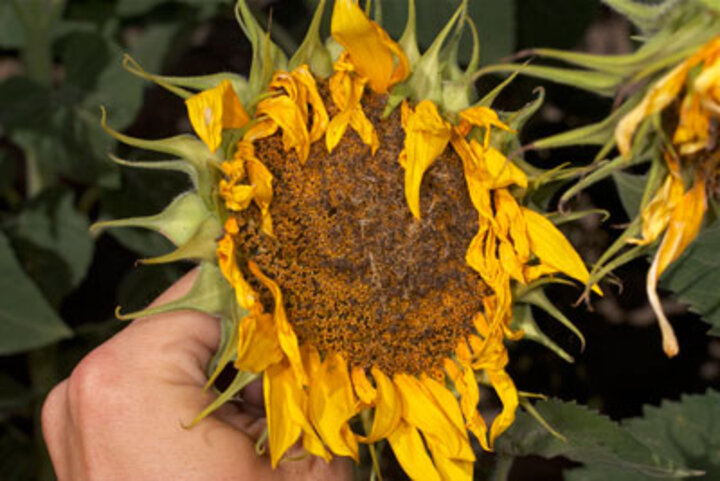
|

|
|
Figure 1. (Left) Sunflower head moth adult (top view) |
July 26, 2012
This content requires Flash Download the free Flash Player now!
//
Get The Code to Embed This Audio Clip
We’re finding high numbers of the sunflower head moth — about one moth per plant — at the Panhandle Research and Extension Center in Scottsbluff and the High Plains Ag Lab near Sidney. Growers are urged to watch for sunflower head moths (Figures 1-2) when scouting.
|

Figure 3. Young larva of a sunflower head moth.

Figure 4. Head damage from young sunflower head moth larvae. Note the wilting petals due to the heavy infestation. (Photos by Jeff Bradshaw) |
The sunflower head moth, Homoeosoma electellum, normally occurs at first bloom and will lay eggs on the green bracts on the sunflower head. Confection fields are often sprayed for seed weevil at first bloom which would also control head moth. Some of the early fields are now in the R4 to R5 stage (late budding to early bloom stage) and some of the earliest blooming flowers will have signs of sunflower moth larvae (Figure 3) feeding visible under the bracts. If you pull back the bracts, you will see frass left behind by insect feeding. Heads with heavy feeding could begin to wilt (Figure 4).
Damaging infestations of sunflower head moth are not common in western Nebraska; however, outbreaks do occur every 7-10 years. We have not had a serious head moth infestation in years, but 2012 is providing optimal conditions to become an outbreak year.
Management
Pyrethroids can help protect sunflowers from sunflower moth damage. These products have a residual activity which is a function of rate — a day per ounce, for example. The R5 stage usually lasts 10-14 days so an application should protect sunflowers for an extended time. Later sunflower plantings (after June 1) usually escape head moth infestation; however, any sunflower approaching or finishing pollination at this time should be monitored closely.
In two to three weeks a second generation of adults will emerge to infest fields. These pests also are in wild sunflower in wheat stubble and road ditches.
Head moth adults are white to tan and 5/8 inch long. They fly at the slightest motion and can be difficult to find during the day unless populations are very large. At dusk or evening they can be found on heads feeding on the pollen or at night with a flashlight.
Sometimes head moth larva can be found on the surface of the head, but they are more easily found around the bracts. The younger larvae feed primarily on florets and pollen while older larvae tunnel through immature seeds. Sunflower moth larvae will consume an average of four to six seeds per larva throughout their development.
Insecticide applications at early bloom (around R5.1) can be made to prevent moths from laying eggs. Scout in the early morning or early evening to get the most accurate counts. When scouting, sample sites should be 75-100 feet from the edge of the field. Use an X-pattern and count moths on 20 heads per sampling site for a total of 100 heads. One moth per two plants is the current economic threshold level and indicates treatment is necessary.
The best opportunity for controlling this insect is to prevent the moths from laying eggs. Once the larvae begin feeding in the head, they become much more difficult to suppress. The longer treatments are delayed after R5.1, the greater the potential for the moths to escape control.
Secondary Damage
Also see in this week's CropWatch |
Larval feeding can also lead to other damage. Any injury or opening to the head provides opportunity for the development of Rhizopus head rot when humid conditions are present (for example, under pivot irrigation). Extreme cases of Rhizopus will result in the head falling to the ground. Careful monitoring should continue through all bloom stages.
Resources
For more monitoring and management information:
- Sunflower Head Moth Mangement, NebGuide G1626
- Register for the High Plains Advanced Sunflower Cropping School August 16-17 for hands-on production-wide training for sunflowers. (See program brochure.)
Jeff Bradshaw
Extension Entomology Specialist, Panhandle REC, Scottsbluff
